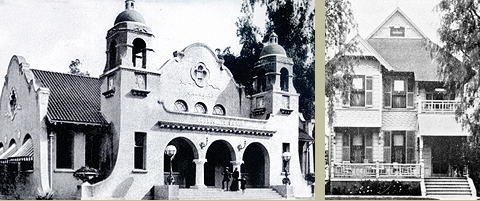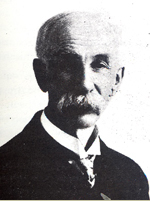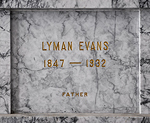
Left: Lyman Evans is credited for making the argument that persuaded Andrew Carnegie to give $20,000 for the construction of a library building in Riverside, shown above. Right: Residence of Lyman Evans in 1906, 454 14th Street.
Lyman Evans came to California in 1887, settling in San Bernardino. He grew up in Iowa and earned his law degree at the State University in Iowa City. He served as a member of the Iowa Legislature from 1882 to 1883. In San Bernardino, he started a general law practice but moved both his household and his practice to Riverside in 1898. He was elected District Attorney in 1898 and served until 1919.
Evans is known for making the final argument that convinced Andrew Carnegie to fund a public library building for Riverside. Evans wife, Mary, was a prominent member of the Riverside Woman’s Club. That group had taken up the cause of lobbying Andrew Carnegie for the funds to build a new public library. The letter writing campaign she started came to naught. Carnegie’s secretary, James Bertram, counseled her to have a public official appeal to Carnegie as one of the criteria for an award was the willingness of local government to commit tax monies for the long term support of the libraries Carnegie funded.
Mary asked her husband to write to Carnegie. Lyman Evans served with George H. Deere, Elmer W. Holmes, and Albert S. White on the Board of Library Trustees. He cited the city’s population of 10,000, the 12,000 volumes in the current public library housed in the Evans Building, the annual rent of $800 per year, the city’s inability to raise construction money through taxes, and the large population of working people who patronized the current library and reading rooms.
On April 16, 1901, Bertram replied for Carnegie, “If Riverside will furnish a suitable site and agree to support a Free Public Library at cost of not less than two thousand dollars a year, Mr. Carnegie will be glad to provide twenty thousand dollars for the erection of a library building.” The library trustees passed a motion accepting Carnegie’s offer and provided the site at Mission Inn Avenue and Orange Street, still occupied by the Riverside Main Library.
Evans also served on the Board of Trustees for the Riverside School District and in 1901 was elected one of the directors of the association formed to build a new county general hospital.
In 1903, Evans played a minor role in the case of embezzler Tom Hays, the man who broke the Orange Growers Bank. Hays was about to be tried in front of Judge Joseph S. Noyes, when the federal court asked for jurisdiction based on the fact that Orange Growers was a national bank. Evans read the letter into the record and Noyes released Hays to the federal government. The Los Angeles Times, critical of the handling of the Hays case, included Evans in its lambasting of local officials for letting Hays get away with an earlier fraud in the purchase of right of way land for the Salt Lake Railroad. The Times later apologized to Evans.
Evans also served as an attorney for Riverside water pioneer Matthew Gage in his lawsuit against the Riverside Trust Company. Gage had come to Riverside as a part of a migration from the Canadian province of Ontario that included engineer and planner George Chaffey and Dr. Joseph Jarvis, whose brother John T. Jarvis followed 10 years later. They settled in an area along California Avenue in the vicinity of Adams and Jackson that became known as the Canadian Tract.
Gage, a jeweler, opened a shop downtown and also began to grow citrus. He filed a claim on Section 30, a barren area bounded by what is today University Avenue, Le Conte Drive, Chicago Avenue, and Canyon Crest Drive. Gaining full title to the claim required he irrigate it. His first attempt, buying land in Box Springs and trying to develop wells there failed. Next, Gage bought the right to the Hunt & Cooley Ditch near Loma Linda to the northeast and he also bought 1,000 acres on the north side of the Santa Ana River in the same location.
The distance between this new source and his Section 30 was 12 miles and would require a mile of tunnel in addition to the canal. Gage secured rights of way and made agreements to supply the land owners along the route with water. Gage also contracted with a land development company, the Iowa Syndicate, to supply water to their 2,000 acres for $167,000 per year. These water agreements allowed Gage to borrow the money he needed to build his canal. On November 7, 1886, the canal transported water to Gage’s land for the first time.
Gage then made a deal with the Riverside Land & Irrigating Company, the entity that had taken over the Riverside Colony at John W. North’s expense. Gage would buy all of the land, 3,200 acres, that the company held above the level of its own canals. The price was $75 an acre and was to be paid as the land in this new Arlington Heights development was sold.
Gage ended up clashing with John G. North, son of Riverside’s founder. North had managed to wrest control of the Riverside Water Company from the Riverside Land & Irrigating Company on behalf of the water users. The Riverside Water Company challenged Gage’s right to the water from the Hunt & Cooley Ditch out of concern for its own water right downstream. Gage compromised, agreeing to a right of the first 300 inches of surface flow, leaving water flowing to Riverside Water Company downstream intakes in all but the driest years.
By the summer of 1889, Gage had spent $200,000 and managed to irrigate Section 30 and bring his canal to Arlington Heights. But he owed $800,000 and needed another half million to complete the work and sustain it.
Gage required financing and the credit had began to contract as the land boom faltered. An English investor, Wilson Crewdson, put together a syndicate, many of whom came from the Price, Waterhouse & Company accounting firm. Crewdson had stayed in 1894 and 1895 at Riverside’s Mission Inn greatly influencing Frank Miller’s future collection of art for the Inn. This group, the Riverside Trust Company, capitalized the project at $1,250,000 and named Gage their general manager.
In order to realize his investment, Gage would have to sell the Arlington Heights lots relatively quickly. The crash prevented sales at the level he needed. In addition, the improvements required more money than the Trust had provided. Gage borrowed personally from Crewdson, securing the loan with his shares in the trust. Eventually, the Trust froze Gage out and he resigned in 1894 and, represented by Lyman Evans, began to conduct a long and ultimately futile series of lawsuits against the Trust. Unable to sell the land quickly enough, Gage was unable to pay off the loan and lost his interest in the Trust.



